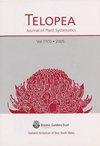文章标题西澳金伯利西北地区的一新种——木犀草
IF 0.5
4区 生物学
Q4 PLANT SCIENCES
引用次数: 2
摘要
本文将来自西澳金伯利地区的Dianella lignosa R.L.Barrett和m.d.b reter (Asphodelaceae)作为一个新种进行了描述,该新种以前被归入长叶Dianella R.Br。新种很容易通过其厚实的木质侧根状茎来识别,并且在叶子和花的特征上也与长叶草不同。本文章由计算机程序翻译,如有差异,请以英文原文为准。
Dianella lignosa (Asphodelaceae), a new species from the north-west Kimberley region of Western Australia
We here describe Dianella lignosa R.L.Barrett & M.D.Barrett (Asphodelaceae) as a new species from the Kimberley region of Western Australia, previously included under Dianella longifolia R.Br. The new species is readily identifiable by its thick, woody lateral rhizomes, and also differs from D. longifolia in leaf and floral characters.
求助全文
通过发布文献求助,成功后即可免费获取论文全文。
去求助
来源期刊

Telopea
PLANT SCIENCES-
CiteScore
1.30
自引率
42.90%
发文量
0
期刊介绍:
Manuscripts submitted for publication in TELOPEA are published online, after peer review and acceptance by the TELOPEA Editorial Committee and when final editorial formatting has been completed. The journal specialises in plant systematics and phylogeny. The geographic scope of the journal encompasses Australia, Malesia, Melanesia, Micronesia, and Polynesia. The suitability of a work for the journal depends on the topic and the region of origin, generally the narrower the focus of the manuscript the closer to New South Wales must be its geographic focus.
As a general guide, we will consider:
1) revisionary treatments and other substantial bodies of work from any of the regions mentioned above.
2) new species from any Australian state.
3) new country records for Australia from any state.
4) new state records from New South Wales only.
However, we aim to support botanical research across the broader Australasian and Pacific region, and will consider submissions on their merit.
Generally we will not consider extraterritorial new country records, or single lectotypification papers unless they pertain to New South Wales taxa, or have significant bearing on the Australian flora.
 求助内容:
求助内容: 应助结果提醒方式:
应助结果提醒方式:


